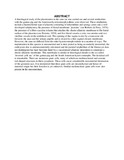Placentation in the cane rat (Thryonomys swinderianus)

View/
Date
1982Author
Oduor‐Okelo, D
Gombe, S
Type
ArticleLanguage
enMetadata
Show full item recordAbstract
A histological study of the placentation in the cane rat was carried out and several similarities with the guinea-pig and the American hystricomorph rodents were observed. These similarities include a haemochorial type of placenta consisting of labyrinthine and spongy zones and a well developed subplacenta; the presence of foetal membrane ‘pustules’ (see Roberts & Perry, 1974); the presence of a fibro-vascular column that attaches the chorio-allantoic membrane to the foetal surface of the placenta (see Perrotta, 1959); and five blood vessels-a vein, two arteries and two vitelline vessels-in the umbilical cord. The opening of the vagina is also by a transverse slit between the anus and the urinary papilla and is closed by a thin vaginal closure membrane.
However, the cane rat differed from the other hystricomorph rodents in a number of ways. The implantation in this species is mesometrial and is inter preted as being secondarily interstitial; the embryonic disc is antimesometrially orientated and the parietal trophoblast of the blastocyst does not disintegrate but later becomes lined by a vascularized allantoic mesoderm to constitute a chorio-allantoic membrane. This membrane is similar in histological details to the so-called ‘inverted yolk sac’ of the guinea-pig and the South American hystri-comorphs. The decidual cell is remarkable. There are numerous giant cells, many of which are multinucleated and contain rod-shaped structures in their cytoplasm. These cells cause considerable mesometrial distensions of the gestation sacs. It is interpreted that these giant cells are mesenchymal and hence of maternal origin but their function is yet unknown. Similar multinucleate giant cells were also present in the mesometrium.
URI
http://onlinelibrary.wiley.com/doi/10.1111/j.1365-2028.1982.tb01083.x/abstracthttp://erepository.uonbi.ac.ke:8080/xmlui/handle/123456789/54359
Citation
ODUOR‐OKELO, D., & Gombe, S. (1982). Placentation in the cane rat (Thryonomys swinderianus). African Journal of Ecology, 20(1), 49-66.Publisher
University of Nairobi, Department of Animal Physiology
